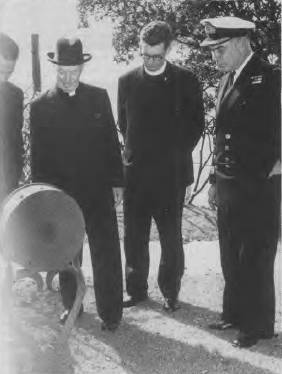- Author
- Lind, L.J.
- Subjects
- History - general
- Tags
-
- RAN Ships
- None noted.
- Publication
- December 1990 edition of the Naval Historical Review (all rights reserved)
Thus in 1970 we saw the Society pass through its formative stage and become recognised as an official organisation with full Naval Board approval. This success opened the gates to further expansion.
A recruiting campaign was initiated concentrating on serving and retired members of the service. Letters to the Editor of the principal newspapers in all States were sent out and met with almost 100 per cent success. These letters outlined the objects and aims of the Society, activities and future plans. A surprising number of applications for membership were received.
Included in this group were many distinguished sailors from the World War 2 period. To mention just a few, Lieutenant Commander L. Goldsworthy, the most decorated member of the RAN, Lieutenant Ian Downs, Coastwatcher, Commander J.C.R. Proud, the secret propaganda officer of the RAN and Captain S. Darling of anti-submarine fame.
The second part of this campaign was directed to serving personnel. Roneoed letters were sent direct to all serving officers together with small notices to be fixed to ships and establishment notice boards. It too, proved satisfactory.

L to R: Mr Lew Lind, Cardinal Gilroy, the Cardinal’s Secretary and Commodore B .W. Mussared, RAN.
Early 1971 brought the support of the Chairman of Staff Committee which was to prove valuable in the years which followed. Admiral Sir Victor Smith was responsible for the appointment of Lieutenant Geoff Vickeridge to study the development of the Museum Repository at Spectacle Island and the place of societies such as ours in the preservation of naval history.
Lieutenant Vickeridge, a member of The Naval Historical Society, was to provide sound advice and support in the two years that followed. He retired from the RAN in the late 1970s and for a time was the manager of a maritime museum in Canada.
Our membership now included many distinguished people from within and outside the service. To mention just a few: Admiral Sir Victor Smith, KBE, CB, DSC, Cardinal Norman Gilroy, Vice Admiral Sir Richard Peek, KBE, DSC, Vice Admiral Sir Henry Burrell, KBE, CD, Rear Admiral H.D. Stevenson, CBE, Right Honorable John Gorton and the Honorable Killen.
Publishing – Naval Historical Review and ‘Ships of the RAN’
This year saw the first issue of The Naval Historical Review. (‘The’ was omitted in all subsequent copies). The first issue was an annual because of the difficulty experienced in obtaining sufficient advertising. A foreword to this issue was written by Vice Admiral Sir Henry Burrell who foresaw the important role the Society would play in promoting the RAN. Contributors were Commander J.C.R. Proud, CBE, VRD, RANVR, ‘The Navy’s Secret War in the Pacific’; Messrs A. Bunnett, G. Halliburton and P. Webb, ‘The Southern Base of the RAN’; Lieutenant Commander Peter Churchill, RN (Ret.), ‘The Tower Building at Garden Island’; Lieutenant R. Atwill, DSM RN (Ret.), ‘ORION Into The Breech’; LS QMG Gallagher, ‘EMDEN-SYDNEY Relics at Penguin’; Alan Payne, ‘British Landing Craft of World War 2’; John Bastock ‘From WARRIOR to VANGUARD’ and Lew Lind, ‘I Have Not Yet Begun To Fight’. All these contributions were excellent material and were a foretaste of the wealth of historical lore to appear in the Naval Historical Review over the next 20 years.
1971 also saw the publication of the first two books in the series ‘Ships of the RAN’. These were ‘HMAS HOBART’ by L.J. Lind and M.A. Payne and ‘HMAS SYDNEY’ by Vice Admiral Sir John Collins. Both books were an immediate success. They sold for $1.00 per copy and both were reprinted within three years.
The preface to ‘HMAS HOBART’ was written by His Royal Highness, Prince Philip. As a midshipman the Prince had taken passage in HMAS HOBART from Aden to Colombo to join his ship HMS RAMILLIES. In the covering letter which accompanied the preface the Prince expressed his delight that the Naval Historical Society of Australia had been formed.




